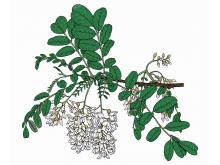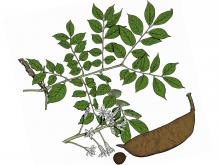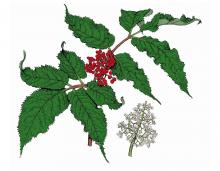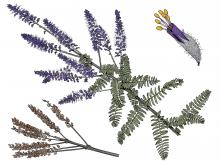Trees, Shrubs and Woody Vines
Media

Species Types
Scientific Name
Robinia pseudoacacia
Description
Black locust, a member of the bean family, is easy to appreciate in May and June, when its showy white clusters of flowers perfume the breeze with their sweet smell. Bees like the flowers, too.
Media

Species Types
Scientific Name
Cladrastis kentukea
Description
Early Appalachian settlers gave yellowwood its name because the root bark produces a clear yellow dye. This slow-growing tree is popular statewide as a landscaping ornamental, but in the wild it is uncommon to endangered throughout its natural range.
Media

Species Types
Scientific Name
Gymnocladus dioicus
Description
There’s no mistaking Kentucky coffee tree when its large, tough seedpods are hanging from its limbs or dropping to the ground below. Unpopular as food with today’s wildlife, these seedpods might have fed mastodons and other large, extinct North American mammals.
Media

Species Types
Scientific Name
Sambucus pubens
Description
Red-berried elderberry reaches 24 feet in height and does not form colonies. Its white flowers, and later, red berries, are in pyramidal clusters. In Missouri, it’s known only from Marion County.
Media

Species Types
Scientific Name
Rosa multiflora
Description
Starting more than a century ago, this nonnative rose was planted across America — for many good reasons — but multiflora rose has proven to be invasive, and now the goal is to stop its spread.
Media

Species Types
Scientific Name
Rubus allegheniensis
Description
Common blackberry is only one of several species of blackberry in our state. It grows in rocky, open woods, along bluffs and fencerows, on glades, and in thickets, old fields, and open valleys nearly statewide.
Media

Species Types
Scientific Name
Amorpha canescens
Description
Lead plant is a densely hairy small shrub producing tight, elongated spikes of small purple flowers from May through August. It grows in prairies, glades, and savannas.
Media

Species Types
Scientific Name
Carya spp.
Description
Hickories are an important part of Missouri’s oak-hickory woodlands and forests. They have tremendous economic value, too. Learn about the nine species of hickory found in Missouri.
Media

Species Types
Scientific Name
Zanthoxylum americanum
Description
Common prickly ash is a thicket-forming shrub or small tree. Its compound leaves resemble of those of ash trees, but it’s in a different family. Pairs of stout, curved prickles occur at each node. Scattered statewide, but less common in the Ozarks.
Media

Species Types
Scientific Name
Fraxinus spp.
Description
Missouri has six species of ashes that you might find in natural settings. They have been very popular as shade trees, and their wood is famously useful. Ash trees of all the species in North America are currently being killed by the invasive, nonnative emerald ash borer.
See Also
About Trees, Shrubs and Woody Vines in Missouri
There are no sharp dividing lines between trees, shrubs, and woody vines, or even between woody and nonwoody plants. “Wood” is a type of tissue made of cellulose and lignin that many plants develop as they mature — whether they are “woody” or not. Trees are woody plants over 13 feet tall with a single trunk. Shrubs are less than 13 feet tall, with multiple stems. Vines require support or else sprawl over the ground.





















